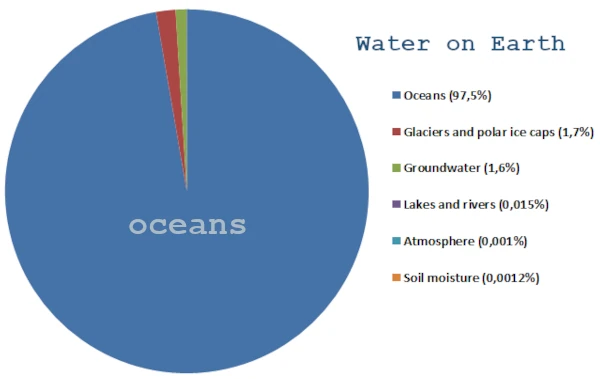
Water on Earth is stored in various reservoirs, from oceans to deep groundwater. These reservoirs are essential for maintaining ecosystems and supplying freshwater to humanity.
Most of Earth's water is found in the oceans, about 97.5% of the total volume. Freshwater accounts for only 2.5%, most of which is frozen in polar ice caps or glaciers.
| Reservoir | Estimated Volume (km³) | % of Total | Comment |
|---|---|---|---|
| Oceans | 1,350,000,000 | 97.5% | Main saltwater reservoir |
| Glaciers and Polar Ice Caps | 24,000,000 | 1.7% | Frozen freshwater, mainly in Antarctica and Greenland |
| Groundwater | 13,500,000 | 1.6% | Includes accessible and deep aquifers |
| Lakes and Rivers | 200,000 | 0.015% | Surface freshwater available for consumption and irrigation |
| Atmosphere | 12,900 | 0.001% | Water in the form of vapor and clouds |
| Soil Moisture | 16,500 | 0.0012% | Water accessible to plants and microorganisms |
Although freshwater represents only about 2.5% of the total water on Earth, its actual availability for ecosystems and human use is even more limited. Most of it is frozen in glaciers and polar ice caps (1.7%), leaving only a small fraction as groundwater, lakes, and rivers.
Accessible freshwater constitutes a tiny fraction of the total terrestrial water, highlighting the importance of sustainable management and protection of aquifers and watercourses for future generations.
Groundwater is the largest accessible freshwater reservoir, with about 13.5 million km³. It is stored in aquifers at various depths. Renewal is slow, ranging from hundreds to thousands of years, depending on rock permeability and recharge by infiltration. Deep aquifers sometimes contain fossil water, which is non-renewable on a human timescale.
Surface water (lakes, rivers, artificial reservoirs) represents only 0.015% of the total volume of Earth's water but is vital for drinking water, irrigation, and industry. Its availability varies greatly by region and season. Major tropical rivers concentrate a significant portion of this water, while arid areas rely mainly on groundwater.
The atmosphere and soil moisture, although representing a small volume compared to oceans or aquifers, are essential to the hydrological cycle. They ensure the redistribution of freshwater through precipitation and the direct supply of terrestrial ecosystems.